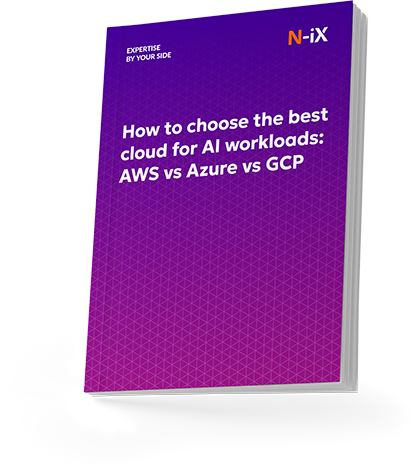AI in cloud computing is a new force transforming how businesses operate and compete. When combined, AI and cloud solutions help organizations streamline operations, cut costs, strengthen cybersecurity, and turn data into actionable insights. A Vanson Bourne study discovered that 50% of surveyed businesses are already increasing their cloud investments specifically to expand their AI capabilities.

So, how exactly do AI and the cloud complement each other, and how can you integrate these technologies into your business? Dive into our expert guide and explore key advantages, real-world applications, and solutions to the most common implementation challenges of AI in the cloud.
How AI and the cloud work together
Artificial Intelligence systems require two essential resources: vast amounts of data and immense computational power. Training advanced models demands not just processing capacity but also efficient access to massive datasets. Additionally, AI workloads frequently require specialized hardware, such as graphics processing units (GPUs) or tensor processing units (TPUs), which are more effective for training deep learning models than traditional CPUs.
While you can build on-premises infrastructure to run your AI workloads, the cloud provides a significantly more cost-efficient solution. Cloud platforms offer on-demand access to storage and high-performance hardware, eliminating the need to invest in expensive setups. The pay-as-you-go pricing model allows you to scale seamlessly, optimize performance, and experiment with AI development without draining your budget.
AWS, Azure, or GCP? Choose the best cloud for AI workloads!


Success!

Key business outcomes of AI in cloud computing
The financial benefits of combining cloud computing and Artificial Intelligence stretch beyond cheaper infrastructure. AI-powered analytics tools can help you continuously monitor cloud resource usage, spotting underutilized services and suggesting optimization opportunities.
Beyond real-time monitoring, AI also plays a key role in strategic cost control. It enables accurate capacity planning, demand forecasting, and predictive maintenance to reduce costs by analyzing historical usage trends and user behavior. This foresight helps businesses prevent over-provisioning and align cloud spending with their actual needs.
Security is another critical area where AI and cloud computing work better together. AI enhances cloud-native security by identifying attack patterns, detecting anomalies, and alerting security teams to suspicious activities before damage occurs. It also helps maintain regulatory compliance by automating audits and generating required reports. In fact, organizations using security AI and automation report 39.3% lower data breach costs compared to those that don’t.
Read more: AI in cloud security: Top 9 use cases

Top 6 real-world applications of AI in cloud computing
Businesses across various industries are already utilizing cloud computing and AI to address real-world problems. Let’s examine several key applications that demonstrate the practical value of this technological partnership.
1. Chatbots and virtual assistants
Companies worldwide now deploy AI-powered chatbots through cloud platforms to handle customer inquiries and automate routine tasks. These conversational tools use natural language processing and language models to comprehend questions, maintain context throughout interactions, and deliver tailored responses. In addition to boosting custom engagement with personalized recommendations, they can also reduce the workload of support teams.
2. Enhanced data analytics solutions
One of the most significant advantages of AI in cloud environments is its ability to convert raw data into actionable business insights. AI algorithms analyze large datasets, identify patterns, and generate accurate predictions much faster than conventional methods. This capability enables real-time analysis and decision-making, eliminating delays in obtaining valuable insights. For instance, by pairing AI with AWS services, N-iX built a sophisticated website content analysis solution for a global media group.
Success story: Content analysis solution
We helped the client analyze competitors’ content effectively and capture promising trends as they were only emerging. To achieve this, we implemented the following:
- Amazon API Gateway for the client to access the system and select the type of topic they wish to search;
- Amazon S3 to store parsed content pieces from competitors;
- Amazon SQS to keep track of articles that have been processed and enriched with statistics.
Utilizing the cloud enabled our team to deliver a solution that gathered and analyzed large volumes of source data quickly and efficiently. Ultimately, our client was able to increase their flexibility and significantly expand their news platform audience.
Read the full case: Facilitating the growth of news platform audience with cloud-based data analytics
3. IoT devices and edge computing
IoT devices generate enormous amounts of data, some of which require immediate processing. AI at the network edge analyzes this information where it’s created, reducing delays for time-sensitive applications.
Cloud platforms complement this setup by managing and updating edge models, aggregating data at scale, and enabling centralized insights. This hybrid edge-cloud approach makes it possible to create decision-making algorithms that respond within milliseconds. This speed is essential for use cases like self-driving vehicles, where sending video data to external servers for processing would take too long.

4. AI automation tools for internal workflows
AI-powered cloud environments excel at handling routine tasks that previously demanded significant manual effort. Cloud providers and their clients use AI to automate essential IT processes, including patching, securing systems, and scaling compute capacity. This automation capability extends beyond basic maintenance to complex business operations such as document processing and manufacturing workflows.
5. Generative AI platforms for content and code
Cloud platforms now deliver powerful generative AI capabilities through straightforward APIs, bringing sophisticated AI models within reach for companies of all sizes. These services help organizations create content, generate code, and build AI agents based on their own data.
Read more: Leveraging AI agents in cloud computing: A comprehensive guide
For software teams, tools like Gemini Code Assist provide AI-powered support in popular code editors, helping build applications faster with higher quality and security. Marketing departments use these same technologies to create and localize content across multiple languages while preserving cultural nuances.
6. Smart inventory and supply chain management systems
AI-powered inventory systems ensure products are available when needed, helping you avoid both overstocking and shortages. Through demand forecasting and predictive analytics, these systems reduce logistics costs, improve inventory levels, and boost service quality.
Advanced AI tools also map supply chains by analyzing various documents, such as orders and customs declarations, providing visibility beyond second-tier suppliers. This enhanced visibility enables businesses to detect and respond to disruptions immediately, minimizing their impact on operations.
Without the cloud, however, such solutions quickly become unsustainable. It was a challenge that our multinational engineering and technology client faced. The client had an internal logistics platform they used to coordinate operations of over 400 warehouses in more than 60 countries. After several months, the client determined that the platform faced limitations in scalability.
The N-iX team helped the client migrate to microservices and developed a new cloud-native infrastructure on Azure Kubernetes Service. This allowed us to smoothly integrate additional features and software as a service (SaaS) solutions, including AI tools. Those services helped the client with the following:
- Anomaly detection for identifying irregular patterns in operations;
- Delivery prediction for estimating arrival times;
- Route recommendations for optimizing transportation paths;
- Object detection in logistics for tracking and inventory accuracy;
- Optical character recognition (OCR) of labels for automated data entry;
- Natural Language Processing (NLP) for document verifications;
- Sensor data processing for monitoring real-time warehouse conditions.
As a result, the client received a scalable and efficient platform. The solution enabled them to automate manual work, streamline inventory management across 400 warehouses, reduce paperwork, and accurately predict warehouse load.
Read the full case: Driving logistics efficiency with industrial Machine Learning
How can businesses get started with AI cloud computing?
Starting on the path of AI in cloud computing demands strategic planning and a clear understanding of available options. Our experts outline several practical steps businesses should take when implementing these technologies.
Choose the right cloud model (SaaS, PaaS, IaaS)
Selecting the appropriate cloud deployment model determines the success of your AI implementation endeavors. Each model offers specific advantages based on your organization’s capabilities and goals:
- Software as a service (SaaS) delivers ready-to-use AI applications requiring minimal technical expertise. This option suits organizations without in-house AI talent, providing immediate access to AI capabilities without development overhead.
- Platform as a service (PaaS) provides development environments optimized for AI, complete with tools, frameworks, and infrastructure. This model works well for businesses wanting to build custom AI solutions without managing the underlying infrastructure.
- Infrastructure as a service (IaaS) supplies raw computing resources, giving maximum control over your AI environment. Organizations with specialized requirements or existing AI expertise benefit most from this approach.

Many organizations find a hybrid cloud approach most effective for AI transformation. This combination lets you take advantage of public cloud scalability while keeping sensitive data in private environments for enhanced security and compliance.
Collaborate with a tech partner for implementation
N-iX cloud experts emphasize that when it comes to AI and the cloud, the right implementation approach is critical for success. Cloud advisory companies like N-iX help clients navigate the complexities of AI cloud implementation by providing expertise in architecture design, technology evaluation, and solution development. We enable you to bridge the skill gap that’s pervasive in this field and provide access to the skilled professionals your project requires.
Use pre-built AI services and APIs
Pre-built AI services accelerate adoption without demanding deep technical knowledge. Major cloud providers offer extensive AI capabilities through straightforward APIs. For instance, Google Cloud delivers tools for document processing, conversation AI, and vision detection. Microsoft Azure provides services for content understanding, language processing, and speech recognition. These services enable quick integration of complex AI capabilities into existing applications.
Train custom models with your data
While pre-built models accelerate implementation, training custom models with your own data often yields superior results. Vertex AI from Google Cloud enables you to train high-quality custom models with minimal Machine Learning expertise.
When developing custom models, data quality becomes the primary success factor that determines the model’s accuracy. Modern cloud platforms include tools to help generate, validate, and refine datasets, ensuring your models have high-quality information to learn from.
3 challenges of using AI in cloud environments
Despite the tremendous benefits of AI and cloud integration, several notable challenges can hinder implementation. Let’s examine the key hurdles businesses face when combining these technologies and our experts’ recommendations for overcoming them.
1. Data privacy and compliance concerns
Integrating AI and the cloud can create privacy challenges if mishandled. AI models often contain sensitive information that attracts cybercriminals, increasing the risk of data theft and exposure. The complexity multiplies when data crosses international borders, becoming subject to various regulatory requirements.
N-iX security experts emphasize that privacy-by-design approaches offer the most effective strategy, addressing compliance requirements from the earliest development stages rather than as afterthoughts. In cloud AI environments, this means securing training data, anonymizing user inputs, and enforcing strict controls over model access and cloud storage. Embedding these practices into architecture not only reduces regulatory risk but also strengthens trust in AI-driven services.
2. Connectivity and latency issues
Latency can present a significant obstacle for AI in cloud computing. As AI models grow larger and require real-time access to enormous datasets, storage and networking bottlenecks severely limit performance. These delays impact critical AI metrics, including response time and processing output.
The physical distance between data centers fundamentally affects latency in hybrid cloud environments, with international transfers experiencing delays of up to 202 milliseconds. Our cloud experts suggest optimizing network architectures and implementing edge computing solutions when appropriate for time-sensitive applications to overcome these challenges.
3. Cost management for compute-heavy workloads
AI workloads can generate substantial expenses without proper oversight. These applications require specialized hardware like GPUs, which command premium prices in the market. Many businesses struggle to optimize these costs, particularly as their AI implementations expand.
Effective cost management demands a clear understanding of AI workload cost drivers and the implementation of proactive cloud cost optimization strategies. These include rightsizing GPU instances, using spot or reserved instances for non-critical tasks, and automating workload scaling based on demand. Cloud providers also offer AI-specific cost-monitoring tools that help track usage in real time.
Wrapping up
AI in cloud computing is reshaping how businesses operate. Together, Artificial Intelligence and the cloud enable smarter decision-making, real-time automation, and cost-efficient scalability. AI brings advanced analytics and automation, while the cloud delivers the flexible infrastructure needed to support demanding workloads and massive datasets. The result? Faster innovation and stronger, data-driven strategies.
To fully capture this potential, businesses need more than just tools—they need a strategy. Choosing the right cloud model, aligning AI initiatives with business goals, and deploying solutions efficiently all require deep technical and domain expertise. That’s where a trusted cloud and AI consulting partner makes the difference. With the right guidance, organizations can move faster, avoid costly missteps, and turn their cloud AI investments into measurable results.
Why should you partner with N-iX for your cloud AI initiatives?
- With 23 years of experience in technology and cloud consulting, N-iX delivers tailored cloud AI solutions for businesses across industries, including finance, retail, manufacturing, and healthcare.
- Our team of more than 400 cloud experts and 200 data and AI specialists implemented over 200 cloud projects, with dozens specifically focused on AI integration.
- N-iX holds partnerships with all major cloud providers, including AWS Premier Tier Services Partner, Microsoft Solutions Partner, and Google Cloud Platform Partner status.
- We remain compliant with leading cybersecurity standards and regulations, including ISO 27001, FSQS, PCI DSS, SOC2, and GDPR, to ensure your data and applications receive top-level security protection throughout the implementation process.
Have a question?
Speak to an expert





